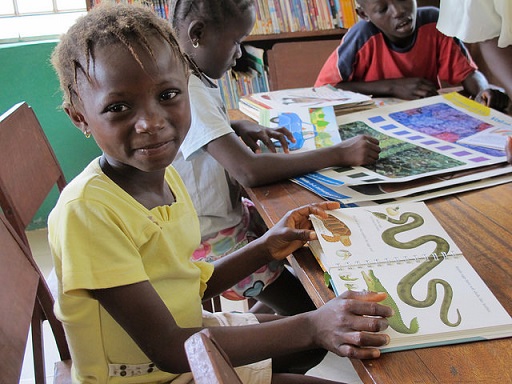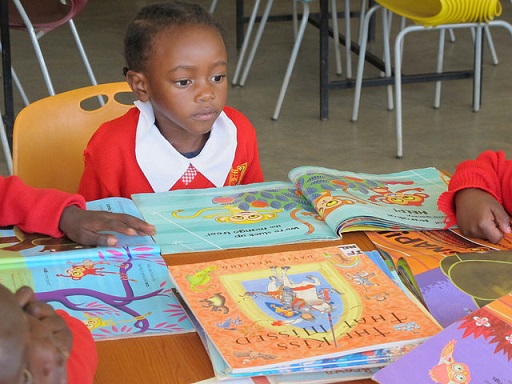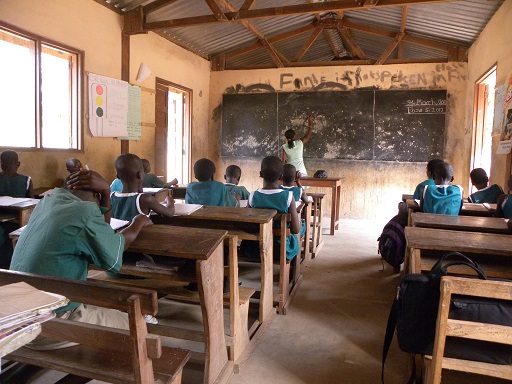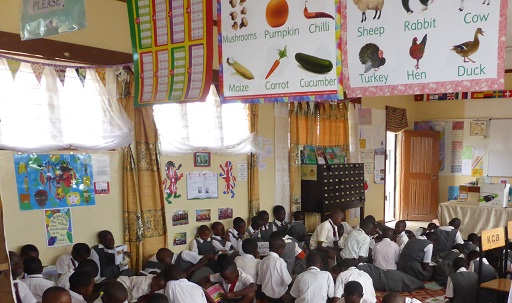Use 'Print preview' to check the number of pages and printer settings.
Print functionality varies between browsers.
Printable page generated Friday, 21 November 2025, 12:16 AM
Section 2: Creating a language-rich learning environment
Introduction
In this section you will:
- learn how to create a print-rich and language-rich environment
- get ideas for creating and finding early reading resources, including using the African Storybook website
- plan how to build regular reading activities into your week.
In Section 1 you thought about the different ways that children learn to read. You looked at the different aspects of literacy and identified a range of things that effective teachers of literacy need to do to support early reading development.
In this section you will look at examples of language-rich learning environments and prepare your own classroom environment to best support early reading. You will use a weekly plan to help you to include different literacy activities within the week. You will also explore the African Storybook website and find free picture storybooks to use in your classroom.
There are seven activities in this section and you will need access to the internet in order to explore the ASb website and complete the quiz. The emphasis is on creating resources and developing an attractive space where children can learn to read.
What is a print-rich learning environment?
A supportive learning environment encourages all children to learn. The children need to:
- feel that they can make mistakes and take risks without being punished
- feel that their ideas and feelings are valued
- be encouraged to talk, listen and actively participate
- be allowed to be noisy as well as quiet
- have chances to learn with their minds (thinking), bodies (moving) and hearts (feelings).
Figures 2.1, 2.2 and 2.3 show you some different types of resources that can make up a print-rich environment. Remember that displays should be regularly changed by the teacher; new curriculum topics are good opportunities to do this.
As well has helping children to feel safe and comfortable, your classroom can be a resource to support their reading. It needs to be ‘print-rich’.
One of the most important aspects of teaching literacy is to create a learning environment that interests children and supports them in developing different literacy skills. A print-rich or language-rich learning environment has as many examples of language in written form as possible. Aside from books, the examples could be simple – food packaging, pictures from old magazines or children’s comics – or, if you have the resources, posters and pictures. Could you ask the children to help you make or gather resources?
Activity 2.1: Print-rich classrooms
Look carefully at the different learning environments in Figures 2.1, 2.2 and 2.3. Write your answers to the questions below in your study notebook.
- What examples of ‘a print-rich learning environment’ do you see in the classrooms?
- Identify two examples of print material in the photographs that you already have in your classroom. Alternatively, identify two examples that give ideas for your classroom.
- Which classroom(s) need(s) greater development in creating a print-rich environment? What one thing could you suggest the teacher introduces?
Record your responses in your study notebook. Look at your own classroom and think about whether a visitor would describe it as a language and print-rich learning environment.
Activity 2.2: Auditing your classroom
Part 1
Answer the questions in this quiz.
Part 2
Arrange to meet with your colleagues to visit each other’s classrooms. Choose three new resources from this table of ideas for making your classroom as language- and print-rich as possible. You will need to complete this before attempting Activity 2.3.
Optional activity: ‘A language-rich classroom’, an OER from the TESS-India website, has several ideas that will help you to create a print-rich and language-rich classroom. How could you adapt these activities for your context?
What resources do you need to support early literacy and reading?
From Section 1 (e.g. Case Study 1.2) you know that a resource may be a thing or a person, for example:
- things to use (such as magazines or storybooks)
- people who could help (such as storytellers – people who can talk about their interesting or unusual jobs or hobbies to children)
- things to make (such as a word wall or alphabet chart).
In Activity 2.2, you explored different types of resources that could be included in a print-rich environment. In Activity 2.3, think practically about how you can find or make each resource.
Activity 2.3: Creating resources
Where will you get resources for a print-rich environment? Try to discuss these ideas for resources with a colleague, including how you could work together to find or make them. You should open or print this table template (or draw a copy of it in your study notebook) and complete it.
Storybooks as resources

Storybooks can be in the form of picture books (where the reader makes up the story) word-books (one word to one picture), simple graded readers, and ‘decodable’ readers, which are specifically created to teach early reading though simple, repeated words and sentence forms. Storybooks can also be creative, with interesting and enjoyable pictures and stories. Storybooks also follow a structure that supports children, making them want to turn the page to find out ‘what happens next’.
Activity 2.4: Thinking about storybooks
Make a list in your study notebook of the first books you remember reading yourself or that someone read to you – in school, at home or in another place, such as church. Even if you do not remember the titles of the books, try to remember what they were about.
- What are the main features of the books you remember when you were an early reader?
- Why did you like them?
- Why do you think you can still remember them?
Discussion
These features may include, for instance:
- pictures that tell a story without words or with only a few words
- pictures that match the words exactly
- familiar situations such as family life, farming or shopping
- humour
- complex language you followed along as someone read to you
- moral or religious messages
- explanations of how things happen or why things are as they are
- traditions or history
- short sentences and simple vocabulary
- large print
- rhyming words
- letters of the alphabet.
When children read storybooks, they:
- learn how to handle books with care
- understand the power of stories and reading
- gain confidence as readers
- learn about their traditions
- develop understanding of dilemmas and problems
- learn word and sentence patterns they can apply to other reading
- learn to use images to interpret words
- learn vocabulary and collocations
- learn to recognise familiar and high-frequency words and phrases that occur regularly in reading – learning just 13 of the most frequently used words enables children to read 25% of any text.
(Note: A collocation is two or more words that often go together and sound ‘right’. For example, we say ‘a fast train’, not a ‘quick train’; we say a ‘quick meal’, not a ‘fast meal’. High-frequency words occur most frequently in books; for example, ‘and’, ‘can, ‘put’ and ‘it’. Some high-frequency words do not follow the usual phonic rules and so they can be hard to read in the early stages. You may call these words tricky or sight words. They are words that children need to learn by sight; for example, ‘the’, ‘look’ and ‘to’.)
African Storybook
African Storybook (ASb) is an initiative of Saide, a South African NGO involved in open education projects across sub-Saharan Africa. The idea of ASb developed over a period of 15 years in Reading Associations across Africa. It grew out of discussions between Judith Baker (a literacy activist from Boston, USA) and Dorcas Wepukhulu (who was a Kenyan teacher in Turkana, at the time). Judith and Dorcas were driven by the observing, ‘How can you learn to read without books? It’s like trying to learn soccer without a ball.’
ASb addresses the shortage of reading material in African languages by enabling African educators and language communities to create and publish their own books through its website with free storybooks and book publishing tools.
The rest of this section will take you through visiting the ASb website and finding a storybook title. (You will also register on the site, so that you are ready for Sections 5 and 6 of this course. It is free to register, but you will need data and good high-speed connectivity to be able to visit the website.)
Activity 2.5: Becoming familiar with the ASb website
Activity 2.6: Finding stories for early reading development
If possible, this is a good activity to do with a partner. You may also want to look at the downloadable resources for using the website and translating stories.
Go to the ASb website and find three or more stories in your language, at least one at Level 1 and at least one at Level 2. Download them on to your own computer or write down the titles.
If you can’t find stories in your language, choose English ones and translate them into your language using the website.
If you found a story in your language but not at the right level, adapt the story using the website.
You will be using storybooks that you have found on the ASb website throughout the rest of the course. So before you begin Section 3, spend some time finding and downloading stories or writing down the titles that you can refer back to later.
Using storybooks

In Section 5 of this course you will focus on how you can develop children’s early reading skills through storybooks. In this section we are going to look at making use of stories in the classroom. Having completed Activity 2.6, you may wish to download other stories you particularly like to use with your classes.
Research has shown that children need to read at least 42 storybooks in a year to reinforce their developing literacy skills. Your storybook collection could include books, stories you have written down or freely available stories like those on the ASb.
When reviewing your collection of storybooks, think about whether they include these features (different storybooks will emphasise or include different features):
- a creative and rich use of language
- opportunities for children to join in
- familiar situations, places and events
- exciting narratives and interesting characters
- drama, conflict and resolutions, journeys or transformations
- interesting dialogue or humour
- a strong link between words and pictures
- repeating words and phrases, with variations
- repeating sentence patterns, changing only one or two words each time
- interesting images (photographs, pictures or drawings) for the children to talk about
- short in length if the storybook is for children to read on their own.
Activity 2.7: Using stories to support children’s early literacy development
Stories can be retold and extended in many ways. In your study notebook, write down the different ways you use stories to support children’s early literacy development.
Discussion
You can help children to:
- tell the story in their own words
- act out the story
- improvise dialogues between characters
- draw or paint the scenes
- tell their own versions of the story
- create alternative endings for the story
- perform the story for the school or for the community
- complete writing activities, such as story maps, lists or book-making.
Many teachers make their own storybooks by writing out stories on chart paper or old cardboard. Teachers also invite people from the local community into the classroom to tell stories rooted in the local culture. In the next activity you will explore resources that provides examples of teachers who did these activities.
Activity 2.8: Resources to help you make good use of stories in the classroom
The TESSA website has resources for teachers with classroom activities to support reading and literacy, as well as a set of ‘key resources’ that explain some of the active teaching approaches that you can use.
Spend some time exploring the literacy materials and the key resources. All the resources are ‘open educational resources’ (OER), which means that they are free and can be copied and adapted.
Share some of the activities you find with a colleague. They will be useful to you later on in the course when you are planning reading activities.
Moving forward
In this section you have learned about the importance of creating a language- and print-rich classroom environment. You have thought about how your classroom can support children’s literacy skills by providing meaningful texts for children. This section has stressed the importance of collecting resources that will motivate children to learn. You have thought about the types of resources you can introduce into the classroom and how you could make them, or ask children to make them as part of the curriculum. You have had the chance to become familiar with the ASb website – a rich collection of stories in many different languages, for different levels of reader.
The rest of this course will focus on teaching and assessing early reading, and on how to make your teaching active and relevant to children’s lives using the tools that you have been introduced to so far. We start in Section 3, ‘Preparing to learn and teach early reading’.



